Abstract
Micrometer-sized surface corrugations produced on Kevlar fiber surfaces by laser ablation were found to dramatically enhance the mechanical adhesion between the fibers and the epoxy matrix in a fiber-reinforced composite. Symmetric and asymmetric corrugation structures were produced by irradiating the fibers with high-fluence UV laser pulses at various incidence angles. The interfacial shear strength (IFSS) between the fibers and the matrix was measured using the microbond fiber-pullout method. Upon laser ablation treatment, the IFSS increased by 120% with symmetric corrugation profiles obtained with laser irradiation normal to the fiber axis, and 5-fold with asymmetric corrugation profiles obtained with the laser incidence angle at 45° to the fiber axis. A similar enhancement was observed in pullout tests under wet conditions. A simple model based on an elementary analysis of the expected strain field in the presence of interface corrugation is found to provide a quantitative explanation of the observed strength enhancement factors.








Similar content being viewed by others
Notes
Equation 2, solved for \( s_{\bot} \), may be interpreted as the power series expansion of the exact (but unknown) dependence of the normal interface strength \( s_{\bot } \) on the applied shear stress \( s_{\parallel } \) up to second order in \( s_{\parallel } \). Since a reversal of the sign of \( s_{\parallel } \) should have no effect on the perpendicular strength, \( s_{\bot } \) is an even function of \( s_{\parallel } \), i.e., the linear term in the power series expansion vanishes.
References
King JA, Buttry DA, Adams DF (1993) Polym Compos 14:301. doi:https://doi.org/10.1002/pc.750140405
Manchado MAL, Arroyo M, Bagiotti J, Kenny JM (2003) J Appl Polym Sci 90:2170. doi:https://doi.org/10.1002/app.12866
Xu Z, Huang Y, Zhang C, Liu L, Zhang Y, Wang L (2007) Compos Sci Technol 67:3261
Song Q, Netravali AN (1998) J Adhes Sci Technol 12:957. doi:https://doi.org/10.1163/156856198X00579
Song Q, Netravali AN (1999) J Adhes Sci Technol 13:501. doi:https://doi.org/10.1163/156856199X00064
Tastani SP, Pantazopoulou SJ (2002) In: Bond in concrete—from research to standards, Publication of CEB-FIP, ACI and JCI, Budapest, Hungary, November 2002, pp 1–8
Ebert EA (1992) US Patent 5127413
Zhou XF, Nairn JA, Wagner HD (1999) Composites Part A 30:1387. doi:https://doi.org/10.1016/S1359-835X(99)00043-3
Tsukamoto Y, Kuroda H, Sato A, Yamaguchi H (1992) Thin Solid Films Switz 213:220. doi:https://doi.org/10.1016/0040-6090(92)90285-J
Mandell JF, Chen JH, McGarry FJ (1980) Int J Adhes Adhes 1:40. doi:https://doi.org/10.1016/0143-7496(80)90033-0
Miller B, Muri P, Rebenfeld L (1987) Compos Sci Technol 28:17. doi:https://doi.org/10.1016/0266-3538(87)90059-5
Herrera-Franco PJ, Drzal LT (1992) Composites 23:2. doi:https://doi.org/10.1016/0010-4361(92)90282-Y
Miller B, Gaur U (1989) J Adhes 29:103. doi:https://doi.org/10.1080/00218468908026480
Murthy NS, Prabhu RD, Martin JJ, Zhou L, Headrick RL (2006) J Appl Phys 100(023538):1
Bahners T, Schollmeyer E (1989) J Appl Phys 66:1884. doi:https://doi.org/10.1063/1.344371
Moore A, Koch M, Mueller K, Stuke M (2003) Appl Phys A 77:353. doi:https://doi.org/10.1007/s00339-003-2193-6
Yip J, Chan K, Sin KM, Lau KS (2004) Polym Int 53:627. doi:https://doi.org/10.1002/pi.1420
Hsueh CH (1992) Mater Sci Eng A 154:125. doi:https://doi.org/10.1016/0921-5093(92)90337-Z
Yue CY, Cheng WL (1992) J Mater Sci 27:3173. doi:https://doi.org/10.1007/BF01116007
Zhou LM, Kim JK, Mai YW (1992) Compos Sci Technol 45:153. doi:https://doi.org/10.1016/0266-3538(92)90037-4
Kim RY, Soni SR (1986) In: Kawata K, Umekawa S, Kobayashi A (eds) Composites ’86: recent advances in Japan and the United States, Proc. Japan-U.S. CCM-III, Tokyo, pp 341–350
Brewer JC, Lagace PA (1988) J Compos Mater 22:1141. doi:https://doi.org/10.1177/002199838802201205
Acknowledgements
The authors acknowledge Y. Kamath for helpful discussions on the experimental aspect of the pullout tests and R. Govinthasamy for preliminary work on this project. The study was funded by the National Science Foundation under award # DMR-0513926.
Author information
Authors and Affiliations
Corresponding author
Rights and permissions
About this article
Cite this article
Bédoui, F., Murthy, N.S. & Zimmermann, F.M. Enhancement of fiber–matrix adhesion by laser ablation-induced surface microcorrugation. J Mater Sci 43, 5585–5590 (2008). https://doi.org/10.1007/s10853-008-2805-9
Received:
Accepted:
Published:
Issue Date:
DOI: https://doi.org/10.1007/s10853-008-2805-9




